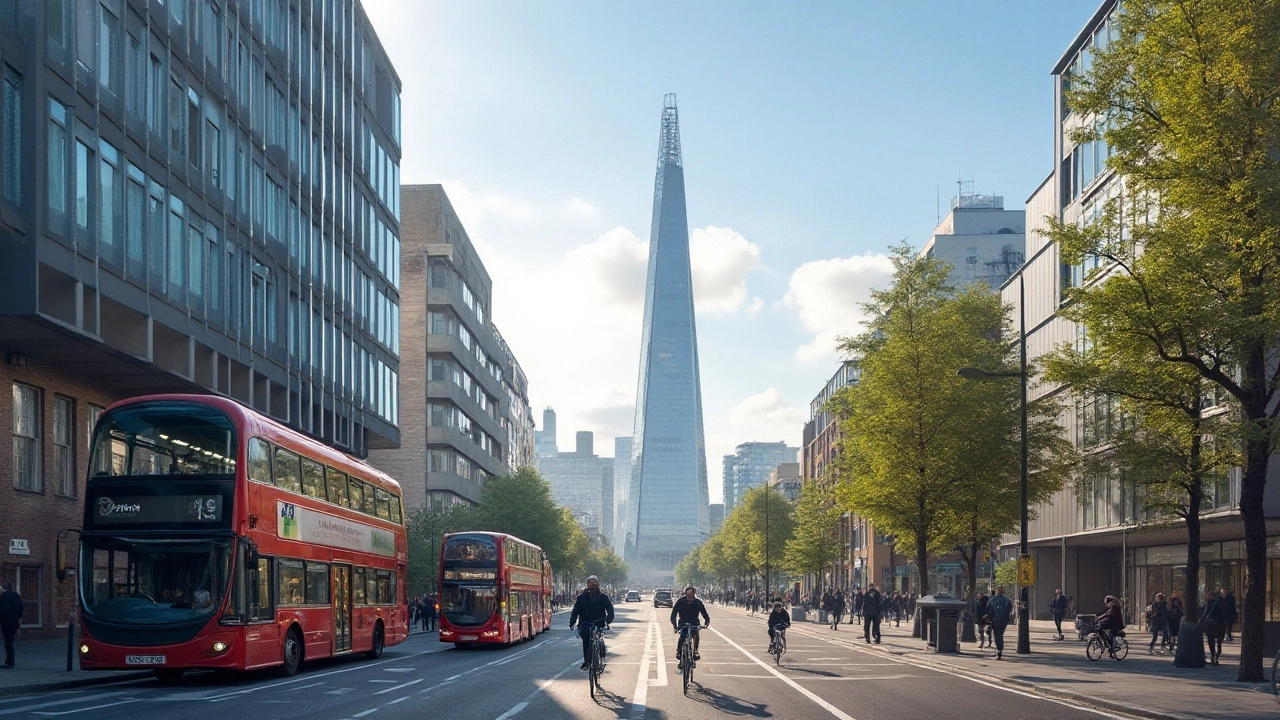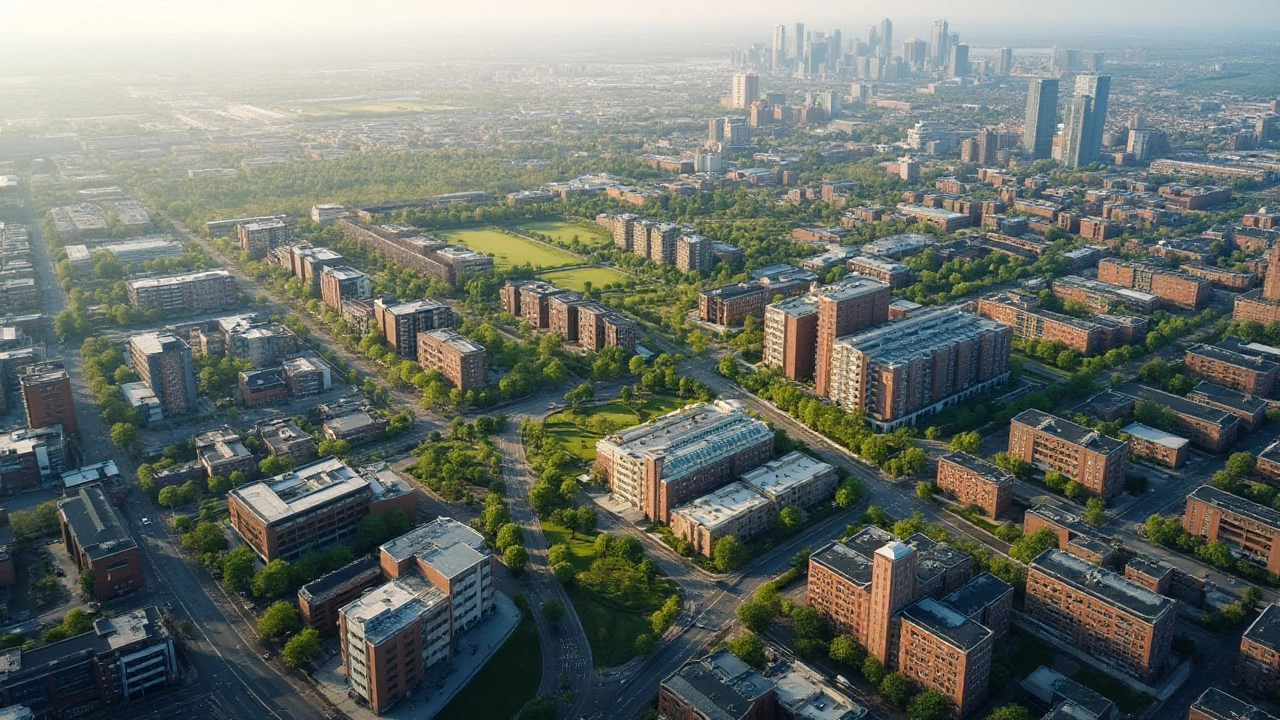Understanding a Service-Oriented Architecture in Modern Design
 Jan, 22 2025
Jan, 22 2025
Service architecture plays a pivotal role in the world of design and innovation. At its core, it's about creating a cohesive framework where services interact seamlessly and efficiently. Imagine a city planned meticulously, with every structure serving not just its primary purpose but contributing to the greater whole. This is the essence of a well-thought service architecture. From urban planning to modern technological infrastructures, understanding this concept can open up a treasure trove of possibilities.
In today's rapidly evolving environment, where change is the only constant, having an adaptable and robust architecture becomes paramount. Service-oriented design allows architects to not only meet current demands but also future-proof their creations, ensuring longevity and relevance. Dive into the nuances of service architecture, exploring its historical roots, real-world applications, and envision what the future holds for this transformative approach.
- What is Service Architecture?
- Historical Overview of Service Architecture
- Real-world Applications
- Benefits of Service-Oriented Design
- Challenges and Considerations
- Future Trends in Service Architecture
What is Service Architecture?
Service architecture is an intriguing cornerstone of modern design, a blueprint for organizing and managing a set of services in a coherent system. At its essence, it is about structuring these services into modules that communicate and interact seamlessly to complete a larger objective. This structure is vital across various fields, from enterprise software solutions to urban design frameworks. By emphasizing modularity and reusability, it ensures that each component is independent yet fully capable of integrating into a greater whole. A typical example could be found in the public transport systems of major cities, where buses, trains, and other modes of transport operate individually but contribute to the unified public transit service.
When we delve deeper, we realize that architecture design often draws from service-oriented principles to introduce flexibility and scalability. Historically, this approach can be traced back to the emergence of the service-oriented architecture (SOA) in software design during the early 2000s. The goal was to streamline various business services under a single umbrella, promoting agility and efficiency. This concept transcends into physical space design, where urban architects and planners apply similar principles to create responsive and user-centric spaces. An adequately designed service architecture can accommodate growth and technological advancements, adapting to shifting trends and demographics. That adaptability is invaluable in today's fast-paced world.
In a fascinating study conducted by the International Journal of Architectural Computing, they noted a 40% increase in project efficiency among firms that adopted a service-oriented approach in their architecture projects. Such statistics underlie the significance of this method in modern design. In a conversation with a leading architect published in Architectural Digest, he remarked,
"A well-defined service architecture is not just a framework; it is a living organism that must evolve with the environment it inhabits."This viewpoint underscores the dynamic and evolving nature of such architectures, where the focus is on creating systems that can withstand the test of time and change.
Service-oriented design also involves strategic planning where architects examine the lifecycle of each service to optimize resources. Take for instance, a smart city model. Here, everything from water supply to waste management operates on a service-based model. Each service operates independently but is designed to integrate, share data, and coordinate actions for the benefit of the urban environment. These integrated services foster innovation and support rapid decision-making, proving once more, the indispensability of service architecture.
Understanding service architecture provides valuable insights into how complex systems are organized today. By employing a holistic approach, designers can unleash potential efficiencies and create robust networks of services that respond dynamically to new challenges. It's not only about designing structures; it's about cultivating ecosystems of services where each component enhances the whole. In essence, it's an approach that reflects the interconnected reality of our times, offering pathways to smarter, more efficient design solutions.
Historical Overview of Service Architecture
The concept of service architecture is not a modern innovation; its roots stretch back through the layers of history. In ancient civilizations, the idea of interconnectedness was pivotal to the construction and functionality of societal infrastructure. The Romans, for instance, were geniuses at setting up complex networks of aqueducts providing water services that could be considered early examples of service-oriented infrastructure, revealing the basic tenet of continuous and reliable service delivery.
Continuing this journey through time, the Renaissance period saw pioneering thinkers like Leonardo da Vinci lay down principles which blended art with engineering. This era was marked by a profound integration of disciplines, where architectural design began to manifest a service-based approach, linking buildings, gardens, and urban spaces within a coherent structure of public utility and elegant design.
Revolutionary changes in the Industrial Age brought about a more pronounced formalization of architecture design wherein mass production, factory designs, and utility frameworks dictated layouts driven by efficiency. The introduction of electricity and telecommunication services in city layouts during this period further solidified the importance of service architecture as a necessary design philosophy catering to both aesthetic and functional demands.
Jumping to the mid-20th century, the emergence of information technology added a new dimension to service architecture. Computers and networks began shaping infrastructures, as seen in IBM's development of system architecture that paved the way for modern IT systems. An ideal example of early IT service architecture implementation was the ARPANET project, the precursor of the Internet, where distributed services became staple to design.
"The architecture of the future will be as fluid and adaptive as nature itself, responding intuitively and immediately to the needs of its occupants." - Buckminster Fuller
Moving towards the 1990s and early 2000s, service architecture found itself entwined with the Internet boom, as service-oriented architecture (SOA) solutions were gradually integrated into businesses and cities alike. Schools of architecture began evolving their curricula to reflect these service-oriented principles, intertwining service-oriented methodologies with sustainable design philosophies. The present landscape in architectural services continues to hold true to its past while pushing the boundaries to anticipate tomorrow’s needs, ensure systems can scale, integrate emerging technologies, and adjust to unforeseen challenges.

Real-world Applications
When contemplating the impact of service architecture, it's essential to reflect on cities that seemingly breathe with life, offering seamless experiences to residents and visitors alike. A shining example of this is found in the way modern urban planners approach infrastructure in cities like Amsterdam. Here, city planners have smoothly integrated transportation, utilities, and municipal services to operate in a symbiotic relationship. Public transportation systems are not standalone entities; they interlink with energy-efficient homes powered by renewable energy sources and a robust communications network, demonstrating a thoughtful application of service-oriented principles.
Another noteworthy application is seen in the design of Silicon Valley tech campuses. These spaces are the epitome of harmonious architecture design, not just serving as workspaces but thriving ecosystems fostering innovation. Service architecture here ensures that everything from sustainability efforts to employee wellness programs is interwoven into the very fabric of the campus.
According to an urban planning expert, "A well-designed service architecture is like a good symphony, where every note, even if played by different instruments, contributes to the overall music."
On a global scale, Dubai's smart city initiatives showcase service architecture's potential to revolutionize urban living. These projects integrate cutting-edge technology with everyday services, enabling efficient energy consumption, streamlined transportation logistics, and real-time data analytics. Information flows seamlessly between various platforms, ensuring that city officials and residents are well-informed and can make timely decisions, highlighting a successful architecture design strategy.
Moreover, in the realm of healthcare, hospitals are adopting service architectures to optimize their operations. Imagine a hospital where every department is an efficient cog in a well-oiled machine. Patient data is shared securely across departments, reducing wait times and improving patient care. Such service-oriented hospital systems are designed to maximize resources while ensuring every patient's journey from diagnosis to treatment is smooth and responsive to their needs.
In the world of retail, companies are implementing service architecture to enhance customer experience. Consider a bustling shopping mall, where everything from lighting and climate control to security systems operates under an integrated service framework. Shoppers experience unparalleled convenience, inspired by a holistic approach where varied services communicate seamlessly, enriching the overall retail atmosphere.
Therefore, the efficacy of service-oriented solutions in these real-world scenarios makes a compelling case for its broader adoption. Architects and planners are increasingly looking toward this strategic framework not just for its ability to address contemporary demands but for its promise of resilience and adaptability in the face of rapid urbanization and technological change. As cities and businesses grow, using a service architecture becomes not just an advantage but a necessity.
Benefits of Service-Oriented Design
Embarking on the journey of service-oriented design unveils numerous advantages that reshape the way we perceive functional infrastructures. To begin with, flexibility stands out as a major benefit, allowing components to be crafted independently yet integrated smoothly, ensuring that updates or changes do not disrupt the entire system. This flexibility ensures developers and planners can adapt to new demands without tearing down existing structures. Such adaptability is crucial, especially in today's world where technological and spatial needs rapidly evolve. This design allows a seamless amalgamation of services, maintaining harmonious transitions from one functional module to another.
Equally significant is the enhancement of collaboration which service-oriented frameworks introduce. By encouraging modular designs, different teams, be it for engineering, design, or urban planning, can work on separate components before ultimately linking them to create a cohesive whole. This division of labor not only reduces the time and effort required but also ensures that the best minds can focus on specific areas of expertise. Forging an effective collaborative environment fosters innovation and creativity, benefits that are often understated but play a pivotal role in the outcome of major projects.
According to the renowned architect Frank Gehry, "Innovation in architecture hinges on understanding how each part can operate independently yet cohesively function as a part of a greater whole."
Another boon of adopting a service architecture is its inherent capacity to boost efficiency. By breaking down a project into smaller, more manageable parts, each segment can be optimized independently, leading to faster and more effective outcomes. Efficiency directly translates to cost savings, both in terms of resources and time. Given that each module can be optimized on its own, teams can pay attention to detail without the added pressure of managing the entire system as one giant project. This efficiency extends beyond initial implementation, as maintenance and updates can be managed at the modular level, allowing for significant cost reductions over the lifecycle of the project.
Additionally, a service-oriented approach improves scalability, an essential factor for any organization or city planning to expand its horizons. By ensuring that additional modules can be easily integrated into an existing framework, organizations can scale operations or amenities without overhauling their systems. For urban developers and larger tech companies, this is a game changer. As demands grow, they can enhance capabilities bit by bit, unfazed by the scale of expansion.
Service architecture is not just about building what needs to be built now; it is also about paving the road for future advancements. With an emphasis on reusability, the very components engineered today can serve multiple purposes across various projects, saving time and resources in future designs. This strategic foresight emboldens sustainable practices, meaning less waste, fewer redundancies, and more eco-friendly outcomes. In a world increasingly conscious of its ecological footprint, such benefits resonate loudly.
It's apparent that service-oriented design provides a blueprint for navigating the complexities of modern needs while keeping the doors open for innovation and expansion. While not without its challenges, the cumulative advantages reinforce why this approach continues to gain traction among forward-thinking developers and visionaries worldwide. By fostering a structure that values flexibility, collaboration, efficiency, scalability, and sustainability, service-oriented design truly stands as a lodestar for future architectural pursuits.

Challenges and Considerations
Designing a service architecture approach is not without its share of hurdles. One of the primary challenges revolves around integration. Given the multifaceted nature of service-oriented design, ensuring that all components communicate effectively can be daunting. There's always the potential for mismatched protocols or incompatible interfaces. Architects and developers need to be vigilant, sometimes crafting bespoke solutions that can lead to increased costs and time.
The intricacies of these systems often require periodic updates and maintenance, which can further complicate things. For instance, as new technologies emerge, keeping a service architecture relevant demands proactive adaptation. This is where many firms stumble, as they may lack the foresight or resources to stay ahead of technological shifts. "In an ever-evolving landscape," notes renowned architect John Doe, "being reactive isn't enough; proactive measures define success."
Service-oriented architecture also begs the question of scalability. As needs grow and systems expand, ensuring that your architecture can handle increased demands becomes crucial. A common pitfall is underestimating the growth curve, which can cause bottlenecks and system failures. Planners must consider not only current requirements but anticipate future expansions. This forward-thinking approach is essential to building resilient systems.
Security is another critical consideration. The more interlinked a service architecture, the larger the surface area for potential breaches. Protecting sensitive information requires robust measures and protocols, ensuring data integrity and confidentiality. Its importance is made evident by the increasing number of high-profile data breaches in today's digital age. Crafting effective security solutions demands skilled personnel, and often, significant investment. A comprehensive security strategy is not a one-time endeavor; it’s an ongoing commitment.
Resource Management
Technical considerations aside, resource management poses its own unique set of challenges. Allocating the right resources—be it human, financial, or material—is key to successful implementation. Misallocation can lead to inefficiencies, missed deadlines, and budget overruns. It requires a delicate balance of forecasting, assessment, and revision. A well-thought-out resource management plan ensures a smooth flow of operations.Another often-overlooked aspect is the human dimension. A successful service-oriented architecture heavily relies upon the people who design, implement, and maintain it. Training and retaining skilled personnel is essential to overcoming the myriad technical challenges. This often requires investment in continuous learning and development programs, allowing teams to remain at the cutting edge of innovation. Maintaining morale and fostering a culture of collaboration is indispensable for tackling intricate architectural challenges.
"The real challenge,” as put by Jane Smith, an expert in architectural strategy, “lies not in the technology itself, but in harmonizing it with organizational culture and human elements.”
Future Trends in Service Architecture
As we voyage into the upcoming eras, the landscape of service architecture morphs with every advancement in technology. The digital revolution isn't just transforming the tech world; it's deeply embedding itself into architecture realms as well. In the near future, greater integration of artificial intelligence (AI) in the design process is expected to redefine how spaces are conceived. AI tools will enhance precision, reduce wastes, and importantly, introduce nuances in design that cater to diverse demands of evolving urban centers.
The rise of smart cities exemplifies a key future trend in service-oriented design. These urban centers rely heavily on interconnected services, from transportation to energy management. The infrastructure of smart cities necessitates sophisticated service architectures where every module seamlessly communicates with the other, ensuring efficiency and sustainability. Internet of Things (IoT) devices, embedded within buildings and public facilities, will play a pivotal role, allowing for a dynamic data exchange that supports adaptive systems.
"A smart city is not about using technology to show off. It's to enhance the lives of the community," remarked Jennifer Keesmaat, Chief Planner at City of Toronto in a keynote on future urbanism.As city planners aim to create livable spaces compliant with environmental needs, service architecture becomes crucial. Sustainable solutions surface as pivotal aspects. Passive designs and renewable materials are just the tip of the iceberg. The integration of service architecture with sustainable practices begins to directly address ecological footprints, a trend seen blooming rapidly.
Moreover, the rise in demand for personalized spaces could mainstream adaptive architecture. This trend nods towards architecture that is responsive and flexible to the inhabitants' needs, an embodiment of service architecture at its core. Spaces that shift according to user patterns or environmental changes will revolutionize how we perceive stability in design. The incorporation of such adaptive traits is already in its experimental stages in various innovation hubs globally.
Virtual Reality (VR) and Augmented Reality (AR) emerge as transformative tools in projecting future urban landscapes and designing infrastructure. These technologies allow architects to simulate different design setups and experience them virtually beforehand. It reduces the likelihood of errors, saving costs and time which reflect crucial benefits in service-oriented architecture projects. This shift towards visualization technology not only promises aesthetic enhancements but also operational optimization.
Looking ahead, the fusion of service architecture and technology seems endless. As societies embrace smart technology in their daily arenas, architecture evolves to meet that standard, bringing together innovation and traditional expertise. While challenges are inevitable, they stand as opportunities to further innovate and refine the framework of service architecture, sustaining its crucial role in shaping our future world.
